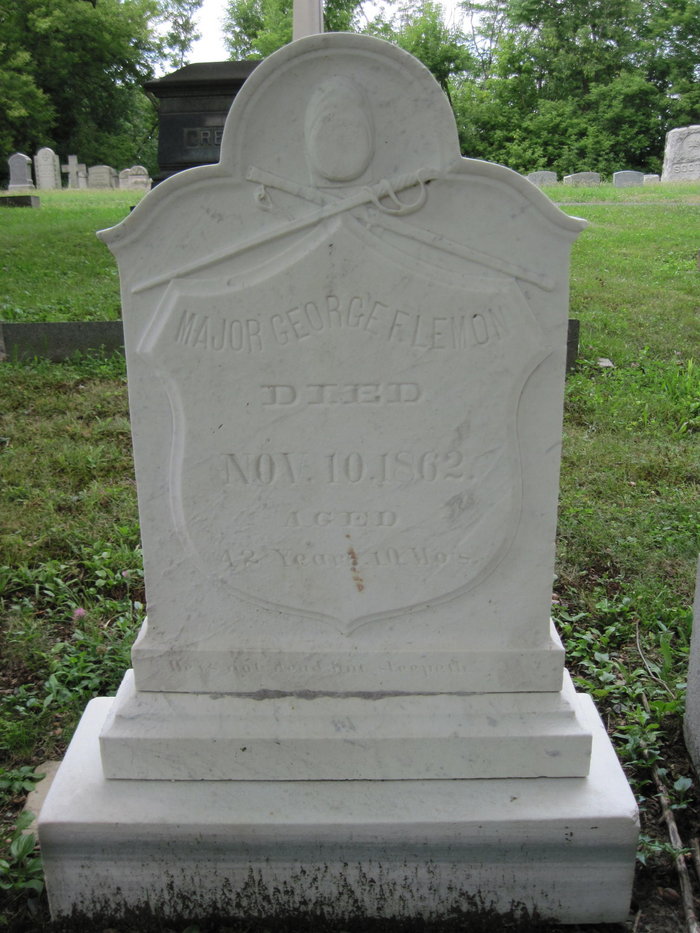Lemon was commissioned second lieutenant and achieved the post of regimental adjutant, a trust he retained until discharged in 1848. Marked for higher calling, Lemon emerged from the political chaos pervading the emerging state as a member of the San Francisco legislative assembly. After statehood was achieved, Lemon was appointed city assessor and held other offices until war fever brought Oregon Senator Edward D. Baker to the stage. Lemon was among the California delegation attending Lincoln’s inauguration and, on the occasion of Baker’s removal to New York City, Lemon was elected major of the newly-formed 32nd New York Infantry ("1st California Regiment") under Baker, a position to which he was again voted when Col. Roderick N. Matheson took command. Throughout the Peninsular and Second Manassas campaigns these senior officers were never far apart.
During the 1862 Maryland Campaign both Matheson and Lemon were mortally wounded in the leg while storming Whipp's Ravine in the Battle for Crampton's Gap, September 14. Both were removed to adjacent Burkittsville for treatment where Matheson died on October 2, Lemon lying alongside his dead body. Lemon's infected leg was amputated on November 9, but he expired next day.
As a mark of respect he was posthumously promoted lieutenant colonel to date from the 10th. His son George, Jr., a private in the 32nd, escorted the remains back to Lansingburgh for the funeral. Before he passed away the major told George how he wished to be buried, instructions he followed to the letter. Lemon was committed to a grave in Oakwood Cemetery wearing full uniform wrapped in his army blanket after the fashion of his deceased soldiers in the field. The Stars and Stripes was spread over his coffin crowned by his cap and sword. The coffin bore a brass plate with the inscription:
MAJOR GEORGE FRANK LEMON
Thirty-Second Regiment N. Y. V. (First California)
Died at Burkittsville, Md., Nov. 10th, 1862
Aged 42 years and 10 months
Lemon and Matheson denote the two highest ranking Union fatalities at the Battle for Crampton's Gap. The site of their mortal wounding is now encompassed by Gathland State Park.
Lemon was commissioned second lieutenant and achieved the post of regimental adjutant, a trust he retained until discharged in 1848. Marked for higher calling, Lemon emerged from the political chaos pervading the emerging state as a member of the San Francisco legislative assembly. After statehood was achieved, Lemon was appointed city assessor and held other offices until war fever brought Oregon Senator Edward D. Baker to the stage. Lemon was among the California delegation attending Lincoln’s inauguration and, on the occasion of Baker’s removal to New York City, Lemon was elected major of the newly-formed 32nd New York Infantry ("1st California Regiment") under Baker, a position to which he was again voted when Col. Roderick N. Matheson took command. Throughout the Peninsular and Second Manassas campaigns these senior officers were never far apart.
During the 1862 Maryland Campaign both Matheson and Lemon were mortally wounded in the leg while storming Whipp's Ravine in the Battle for Crampton's Gap, September 14. Both were removed to adjacent Burkittsville for treatment where Matheson died on October 2, Lemon lying alongside his dead body. Lemon's infected leg was amputated on November 9, but he expired next day.
As a mark of respect he was posthumously promoted lieutenant colonel to date from the 10th. His son George, Jr., a private in the 32nd, escorted the remains back to Lansingburgh for the funeral. Before he passed away the major told George how he wished to be buried, instructions he followed to the letter. Lemon was committed to a grave in Oakwood Cemetery wearing full uniform wrapped in his army blanket after the fashion of his deceased soldiers in the field. The Stars and Stripes was spread over his coffin crowned by his cap and sword. The coffin bore a brass plate with the inscription:
MAJOR GEORGE FRANK LEMON
Thirty-Second Regiment N. Y. V. (First California)
Died at Burkittsville, Md., Nov. 10th, 1862
Aged 42 years and 10 months
Lemon and Matheson denote the two highest ranking Union fatalities at the Battle for Crampton's Gap. The site of their mortal wounding is now encompassed by Gathland State Park.
Family Members
Advertisement
Explore more
Sponsored by Ancestry
Advertisement





